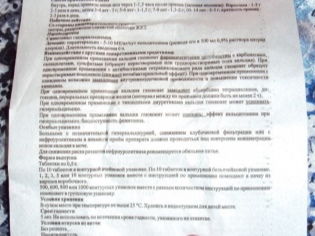Calcium gluconate for the treatment of children
«Calcium gluconate"- a domestic drug that is well known to many generations. To this day, it remains the most prescribed calcium drug of all possible options. After reading this article, you will learn when and why a child may need this medicine, how to use it to treat children and what should be taken into account.
About the drug
At the chemical level, calcium gluconate is a salt that is formed as a result of the interaction of calcium and gluconic acid. It turns out white tasteless powder, which is easily dissolved in water, but can not dissolve in alcohol or ether at all.
In medicine, it is considered a valuable mineral supplement, which has an excellent therapeutic effect for patients in a state of hypocalcemia. This term refers to the lack of calcium in the body.
Calcium is very important for children, because it provides protection of bone tissue, the strength of teeth, and also participates in the process of blood formation (responsible for blood clotting), plays an important role in the normal functioning of the muscular skeleton, as well as the cardiovascular and nervous systems. Without calcium, the pancreas and thyroid gland will not function normally in sufficient quantities.
It should be noted that calcium performs all these functions successfully only if it interacts with magnesium, phosphorus and vitamin D. Therefore, a sufficient amount of them is very important for calcium to be fully absorbed and have a positive effect.
In children during the period of intensive growth the need for calcium is great. But this does not mean that everyone, without exception, should take Calcium Gluconate for prevention. This drug is prescribed by a doctor only to those children who really need it. Otherwise, there is a surplus of calcium, and this condition (as well as a deficiency) is quite dangerous for the health and life of the baby.
Indications for use
Find out if your child needs this drug, you can visit the doctor and pass blood tests for biochemistry. He will tell you what concentration of calcium is present (this parameter is defined in mmol per liter), whether this level is sufficient. Usually the drug is recommended for the following conditions and diseases:
- hypocalcemia caused by malnutrition or poor nutrition;
- hypocalcemia accompanying various pathological changes in blood formation, with low blood clotting;
- osteoporosis - a disease in which the bone skeleton softens, loses strength;
- imbalance of nutrients, metabolic disorders - vitamin D deficiency;
- with established and confirmed rickets;
- with the urgent need to obtain a mineral (during the very rapid growth of the child or the eruption of several teeth at once);
- with large losses of calcium associated with taking diuretic drugs, prolonged illness, during which the child was forced to lie in bed for a long time, with prolonged diarrhea, as well as during treatment with antiepileptic drugstore;
- in case of allergies - both acute and chronic, expressed in cutaneous manifestations (urticaria, dermatosis) and in respiratory (in allergic rhinitis, angioedema, bronchial asthma);
- with various bleeding;
- with muscle weakness (myoplegia);
- with liver pathologies caused by exposure to certain toxins;
- for colds, frequent and severe acute respiratory viral infections, acute respiratory infections - to increase vascular permeability, which can be disrupted due to the effects of an inflammatory infectious process;
- with some jade.
Release form
The drug exists in two pharmacological forms - in tablet and solution for injections. Tablets (dosages of 250 mg and 500 mg) are both hard and chewable. The solution is designed specifically for intramuscular and intravenous administration.
For children's home use is suitable exclusively for the preparation of calcium salts in tablets. The solutions are used for adult patients, they are often used by ambulance doctors (in situations requiring urgent response - with severe blood loss, with allergic edema or shock, for this purpose the drug is administered intravenously or used in droppers). Children can also be given the drug intravenously - at a very low rate of administration. However, this must be very compelling evidence. In no case can you do this on your own.
Instructions for use
Tablets before use should be thoroughly crushed. Children are given the resulting powder with a small amount of water or breast milk. It is important to observe the age dosage, because an excess of calcium causes big problems. Doses for children:
- for infants up to 1 year old and for newborns - not more than 0.5 g;
- for children aged 2 to 5 years old - 1 g each (maximum daily dosage should not exceed 3 g);
- children from 5 to 7 years old - 1.0-1.5 g (not more than 4.5 g per day);
- children from 7 to 10 years old - 2 g (not more than 6 g per day);
- children from 10 to 13 years old - 2.0-2.5 g (not more than 8 g per day);
- adolescents from 13 years old - 3 g (not more than 9 g per day).
The daily dose of the drug is better divided into 2-3 doses. Give the child medication before meals or an hour and a half after eating. The crushed tablets must be washed down with water or milk. Regarding the use of milk when taking calcium supplements - doctors still have not come to a common opinion. Many experts argue that it is better to use ordinary water, avoiding dairy products.
However, in the official instructions for the drug the possibility of using milk is indicated - as a completely acceptable alternative. If in doubt, it is best to ask this doctor.
During a severe allergic reaction (especially in the acute stage), Calcium Gluconate is prescribed to the children along with taking antihistamine medication, since calcium enhances their effect. In case of inadequate reaction to any other medications, calcium can be recommended as a remedy that can eliminate other people's "side effects".
The course of therapy with calcium tablets on average is quite long - from 10 to 30 days. For some children, as indicated by the doctor, the course may be extended.
The so-called hot injection (10% calcium gluconate solution), preheated to body temperature, is administered in an amount of not more than 5 ml intravenously. This should be done every two or three days - in case of severe blood loss and convulsions that pose a certain danger to the child, in case of poisoning with magnesium salts and severe skin diseases. Almost always - with acute and violent allergies that threaten the child’s life, which are associated with the onset of edema and difficulty breathing.
Children should not be injected into muscle and subcutaneous solutions, the risk of tissue necrosis is too great.
Contraindications
The drug should not be given to children with certain contraindications. These include:
- idiosyncrasy, sensitivity to calcium;
- hypercalciuria - a condition where mineral salts are excreted in excessively high concentrations in the urine;
- hypercalcemia - calcium oversupply;
- tendency to increased blood clotting, the formation of blood clots;
- atherosclerosis;
- with complex and severe varieties of renal failure;
- sarcoidosis.
Side effects
Usually, no associated unpleasant effects in the use of this tool is not observed, if the dosage and schedule of therapy are not violated. Only in a small percentage of cases the following phenomena may occur:
- heart rhythm disorder (like bradycardia);
- glut of calcium;
- high content of calcium in the urine;
- nausea and vomiting;
- diarrhea or constipation;
- swelling of the legs, frequent urination (for kidney disease);
- the formation of stone-like deposits of mineral salts in the intestine (with long-term intake of high doses of the drug);
- allergic reaction.
Overdose symptoms
The overabundance of mineral in a child is not immediately noticeable, but only some time after the start of taking increased or unreasonable doses. Hypercalcemia can manifest itself with the following symptoms:
- constipation or prolonged diarrhea;
- vomiting;
- abdominal pain (in the abdomen);
- muscle weakness;
- high blood pressure;
- the formation of kidney stones;
- in severe cases - loss and confusion, hallucinations, coma.
Analogs
- "Calcium glycerophosphate";
- Calcium Sandoz;
- “Calcium D” - syrup;
- Calcium D3 Nycomed;
- «Kaltsinova».
Quite often, this useful and essential mineral is included in the composition of multivitamin complexes for children. However, these drugs can not be considered therapeutic. They are designed to prevent a deficiency of this beneficial substance, and not to treat conditions that have occurred due to a lack of calcium.
Reviews
Many parents claim that their children tolerate Calcium Gluconate in tablets, and this drug does not cause any side effects to babies.
In terms of efficiency - this drug is very profitable, inexpensive. Some complex drugs with calcium are much more expensive. Experienced mothers who have tried all the options did not feel much of a difference in the action and well-being of the child after the treatment, and therefore spending no more sense.
In the reviews they say that some children had a slight discomfort in the stomach at the beginning of the treatment with the drug, there were problems with the stool (constipation or diarrhea), but it passed pretty quickly.
Most often, the drug is prescribed for children with allergies. If the child is already 3 years old, such pills help themselves (practically without the help of other medicines) to save the baby from a minor allergic reaction.
Practical tips:
- Many mothers prefer to give children calcium for prevention. However, it should not be tablets and syrups. For these purposes, suitable cottage cheese with calcium gluconate. You can cook it for a simple and accessible to all recipe.
Per liter of milk, take 10 tablets of the drug. Milk is heated, but not brought to a boil. The tablets are crushed and added to milk. When the milk is curdled, the curd is thrown back onto the gauze, the whey is allowed to drain, after which the product is given to the baby.
- Neither drugs nor homemade calcined curds will bring any benefit if the child has a lack of vitamin D in the body. In order for calcium to be sufficiently absorbed, the child must be more often outside, since vitamin is formed in the skin when exposed to sunlight. If for some reason there is no such possibility, then the child should be prescribed vitamin D preparations.
- The newborn doesn’t need a special preparation because they receive the necessary daily dose of the mineral with breast milk from the mother. (or as part of adapted milk formulas, if the child is artificially fed). If the mother after birth suffers calcium deficiency (her hair has become dull, her nails are broken, there are problems with her teeth), let her start taking the drug herself. Calcium gluconate passes into breast milk, and the baby gets it in this form.
Dr. Komarovsky lists the main signs of calcium deficiency in the body. You can also read Dr. Komarovsky’s opinion on calcium gluconate for children in another article.





































